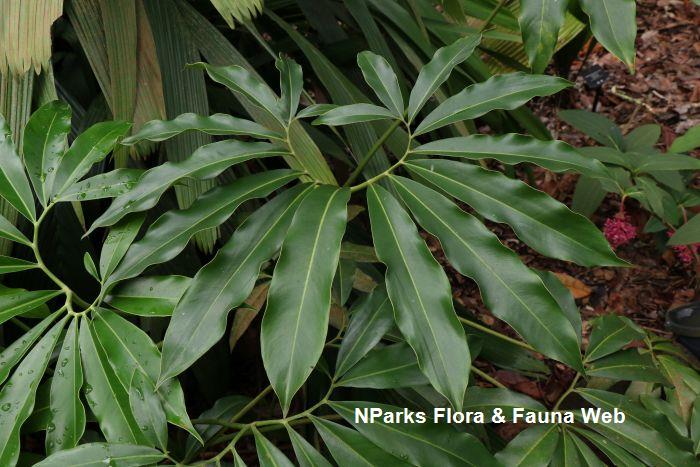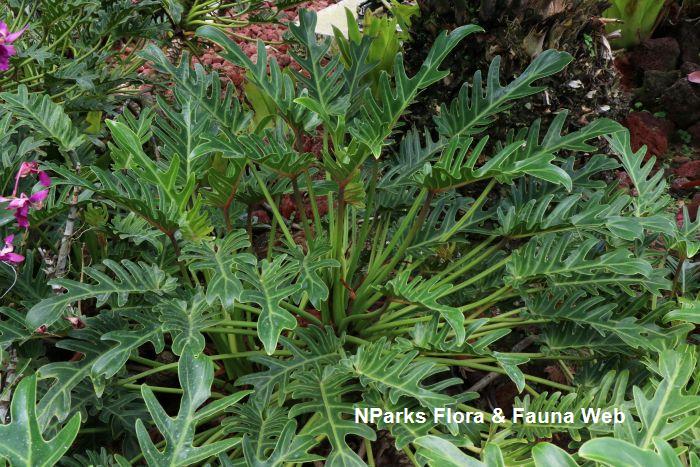
Back
Thaumatophyllum bipinnatifidum (Schott ex Endl.) Sakur., Calazans & Mayo
| Family Name: | Araceae |
| Synonyms: | Philodendron bipinnatifidum Schott ex Endl., Philodendron selloum K.Koch, Arum pinnatifidum Vell., Philodendron pygmaeum Chodat & Vischer |
| Common Name: | Split-Leaf Philodendron, Cut-leaf Philodendron, Tree Philodendron, Horsehead Philodendron, Fiddle-leaf Philodendron, Lacy Tree-Philodendron, Banana-de-macaco, 林芋, 春芋, 双翅叶薯 |
The Spilt-leafed Philodendron (Thaumatophyllum bipinnatifidum) is a perennial, climbing aroid with twice-pinnately lobed leaves. It is commonly sold as a houseplant but is suitable for bright or shady corners of parks, gardens, and courtyards. Its inflorescence has been observed to generate heat, spreading odour that attracts their beetle pollinators.
Name
Classifications and Characteristics
| Plant Division | Angiosperms (Flowering Seed Plants) (Monocotyledon) |
|---|---|
| Plant Growth Form | Climber, Herbaceous Plant |
| Lifespan (in Singapore) | Perennial |
| Mode of Nutrition | Autotrophic |
| Plant Shape | Irregular |
Biogeography
| Native Distribution | South to Southeast Brazil, Bolivia, Paraguay, Northeast Argentina |
|---|---|
| Native Habitat | Terrestrial (Riverine, Primary Rainforest, Monsoon Forest, Coastal Forest) |
| Preferred Climate Zone | Sub-Tropical / Monsoonal, Tropical |
| Local Conservation Status | Non-native (Horticultural / Cultivated Only) |
Description and Ethnobotany
| Growth Form | It is a perennial, climbing or hemiepiphytic aroid. Younger and smaller plants may grow erect but eventually might require support as the plant gets older. |
|---|---|
| Roots | The adventitious roots grow from stem nodes and aid in anchoring the plant to tree trunks or any climbing support. |
| Foliage | The leaves are deeply dissected into several wavy-margined lobes, with the leaf blade growing up to 75-120 cm. The upperside of the leaves is dark green and glossy, while the underside is paler. The petiole (leaf stalk) can reach 70-150 cm long. Younger plants may have leaves with shallower lobes and will eventually be more dissected as they mature. |
| Stems | The stem can get up to 5-13 cm in diameter and has prominent eye-like leaf scars. |
| Flowers | The inflorescence is a green spadix, subtended by a spathe; both are borne on the leaf axil. The spathe is creamy-white inside and purplish-red or maroon-brown on the outside. The spadix can reach up to 15-28 cm tall, with male flowers at the upper part of the spadix, sterile male flowers in the middle portion, and female flowers towards the base. Each flower is highly reduced to either stamens on males or a single pistil on females. The inflorescence exhibits floral thermogenesis, generating heat over 2-3 days to release insect-attracting odour. |
| Fruit | The infructescence is a cluster of berries that ripens to white or yellow. |
| Habitat | It can be found in rainforests, gallery forests, and various seasonal forest types, including cerrado. It can also be found in open swampy areas and on rocks in open shrubby coastal and submontane vegetation. <1> |
| Similar | This species may resemble Thaumatophyllum xanadu but can be differentiated by the compact size, and erect, single-pinnately-lobed leaves. |
| Associated Fauna | In its native range, the flowers are pollinated by Cyclocephala beetles, specifically C. variolosa. <2> |
| Cultivation | It can be propagated from stem cuttings. |
| Etymology | The genus Thaumatophyllum is derived from the Greek thaumato, "wonder, miracle" and phyllon, "leaf", referring to the beautiful and peculiar leaves of the type species (Thaumatophyllum spruceanum). The specific epithet bipinnatifidum means "twice pinnately split", referring to the deeply lobed margins of the lobed leaves. |
| Ethnobotanical Uses | Cut - Dried Flower: The leaves are often used in floristy for foliage. |
Landscaping Features
| Landscaping | It is suitable for shady areas, courtyards, planter beds next to pools and water features, and indoor planting. |
|---|---|
| Desirable Plant Features | Ornamental Foliage |
| Landscape Uses | General, Parks & Gardens, Interiorscape/ Indoor Plant, Swimming Poolside, Container Planting |
| Thematic Landscaping | Naturalistic Garden |
| Usage Hazard - Cons | Irritant - Sap, Toxic Upon Ingestion |
| Usage Hazard - Cons Remarks | Irritant - Sap, Toxic Upon Ingestion: All parts of plant contains calcium oxalate crystals in their sap, causing mouth and throat irritation if ingested, and possible itchiness if in contact with the skin. Keep away from pets and children. |
Fauna, Pollination and Dispersal
| Pollination Method(s) | Biotic (Fauna) (Insects (Ant, Beetle, Fly, Thrip, Wasp)) |
|---|
Plant Care and Propagation
| Light Preference | Semi-Shade, Full Sun |
|---|---|
| Water Preference | Moderate Water, Occasional Misting |
| Plant Growth Rate | Fast to Moderate |
| Rootzone Tolerance | Fertile Loamy Soils, Easy to Grow |
| Maintenance Requirements | Low |
| Pest(s) | Sucking Insects |
| Propagation Method | Stem Cutting |
Foliar
| Foliage Retention | Evergreen |
|---|---|
| Mature Foliage Colour(s) | Green |
| Mature Foliage Texture(s) | Glossy / Shiny |
| Foliar Modification | Flower/Fruit Bract |
| Foliar Type | Simple / Unifoliate |
| Foliar Arrangement Along Stem | Spiral |
| Foliar Attachment to Stem | Petiolate |
| Foliar Shape(s) | Non-Palm Foliage (Sagittate) |
| Foliar Venation | Dichotomous |
| Foliar Margin | Irregularly Incised, Pinnately Lobed / Pinnatifid |
| Foliar Apex - Tip | Acute |
| Foliar Base | Sagittate |
| Typical Foliar Area | Mesophyll ( 45cm2 - 182.25 cm2 ) |
| Leaf Area Index (LAI) for Green Plot Ratio | 3.5 (Shrub & Groundcover - Monocot) |
Non - Foliar and Storage
| Stem Type & Modification | Herbaceous |
|---|---|
| Root Type | Underground (Fibrous Root), Aboveground (Aerial Root) |
Floral (Angiosperm)
| Flower & Plant Sexuality | Unisexual Flowers , Monoecious |
| Flower Colour(s) | Cream / Off-White, Green |
|---|
| Flower Grouping | Cluster / Inflorescence |
| Flower Location | Axillary |
| Flower Symmetry | Radial |
| Inflorescence Type | Spathe & Spadix |
| Ovary Position | Superior / Hypogynous |
| Flowering Opening Time | Recurring (Night Open - Day Closed) |
| Flower Lifespan on Plant | 2 - 3 days |
| Flower Lifespan on Plant - Remarks | Female flowers mature on the first night and the male flowers mature in the second and sometimes into the third night |
| Flowering Habit | Polycarpic |
Fruit, Seed and Spore
| Mature Fruit Colour(s) | White, Yellow / Golden |
|---|---|
| Mature Fruit Texture(s) | Smooth |
| Fruit Classification | Simple Fruit |
| Fruit Type | |
| Seed Quantity Per Fruit | Few (1-5) |
References
| References | <1> eMonocot Team Philodendron bipinnatifidum - Schott ex Endl. CATE Araceae https://cate-araceae.myspecies.info/taxonomy/term/1774/descriptions (accessed 26 February 2025) <2> Gottsberger, G., Silberbauer-Gottsberger, I. & Dötterl, S. (2013). Pollination and floral scent differentiation in species of the Philodendron bipinnatifidum complex (Araceae). Plant Syst Evol 299, 793–809. <3> Sakuragui, C.M. et al. (2018). Recognition of the genus Thaumatophyllum Schott − formerly Philodendron subg. Meconostigma (Araceae) − based on molecular and morphological evidence. PhytoKeys 98: 51–71. |
|---|
Image Repository
Others
| Master ID | 177 |
|---|---|
| Species ID | 1473 |
| Flora Disclaimer | The information in this website has been compiled from reliable sources, such as reference works on medicinal plants. It is not a substitute for medical advice or treatment and NParks does not purport to provide any medical advice. Readers should always consult his/her physician before using or consuming a plant for medicinal purposes. |








